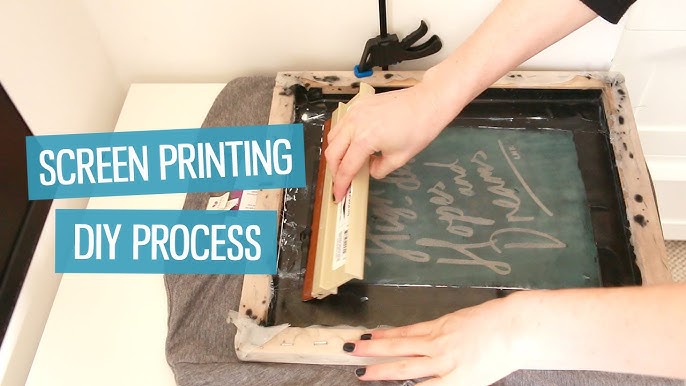ChatGPT said: Why nonprofits prefer 10:9 Design LLC Company for bulk printing
The Vital Overview to Understanding Screen Printing and Its Versatile Utilizes
Screen printing has an abundant history that dates back to ancient times, progressing right into an advanced method used across various markets today. This overview explores the intricacies of the screen printing process, detailing its applications in advertising and marketing, home, and fashion décor - 10:9 Design Screen Printing. Understanding these basics can open innovative possibility for both imaginative and industrial jobs. The following sections will expose essential tips and methods to enhance one's screen printing undertakings
The Background of Screen Printing
Although screen printing has roots that map back centuries, its development reflects the creative and technical advancements of numerous societies. Coming from old China, the method was at first made use of for embellishing fabrics and later infect Japan, where it ended up being indispensable to Ukiyo-e woodblock printing. The technique changed to Europe in the 18th century, where it gained popularity amongst craftsmens and industrial printers. The development of image emulsion in the 20th century transformed screen printing, permitting more detailed layouts and higher performance. Musicians like Andy Warhol better thrust its appeal, using the medium to develop legendary works that mixed commercialism and art. By the late 20th century, screen printing had developed itself as a versatile method, utilized in fashion, marketing, and art. Today, it proceeds to progress, integrating electronic modern technology and broadening its applications across different industries.
The Screen Printing Process Explained
Screen printing transforms artistic visions into concrete layouts through a series of specific steps. At first, an image is created and after that transferred onto a screen, typically made from fine mesh material stretched over a structure. A light-sensitive emulsion is applied to the screen, which is exposed to light, solidifying in locations not covered by the photo. After washing out the unhardened emulsion, a stencil is developed.
Next off, the screen is put over the substratum, whether it be fabric, paper, or one more material. Ink is then pressed through the open locations of the pattern using a squeegee, transferring the style onto the substrate listed below. This process can be repeated for multiple colors, requiring separate displays for every tone. Ultimately, the published product is treated making use of warmth to guarantee the ink adheres properly, leading to a durable, vivid design on-line.
Kinds of Screen Printing Techniques

Furthermore, specialized methods, such as discharge screen printing, get rid of dye from the fabric to create softer prints, while foil screen printing uses metallic aluminum foil to attain a glossy finish (10:9 Design reviews). Each technique offers distinctive qualities, accommodating numerous innovative needs and manufacturing scales, inevitably expanding the opportunities within the screen printing domain
Applications of Screen Printing in Numerous Industries

Additionally, the signage and marketing markets make use of screen printing for producing eye-catching screens and banners. This technique permits bold colors and complex styles that capture interest. In electronics, screen printing is utilized for applying conductive inks to circuit boards, crucial for element links. The home décor industry embraces screen printing to produce distinctive styles on fabrics and wall art. Overall, screen printing offers as an essential tool throughout diverse fields, enhancing products with personalized and visually attractive graphics.
Tips for Successful Screen Printing Projects
While embarking on a screen printing project, cautious attention to information can substantially improve the last end result. Picking premium materials is necessary; this includes the screen, inks, and substrates. Using proper mesh matters can affect ink deposition and detail resolution. Preparation is just as vital; extensive cleaning of screens and correct exposure times assure crisp prints.
Next, precise enrollment is crucial for multi-color prints. Utilizing alignment tools can aid attain exact layering. In addition, screening prints on scrap products before manufacturing assists identify prospective concerns without wasting sources.

Frequently Asked Inquiries
What Products Are Best for Screen Printing on Fabric?
Cotton and polyester blends are excellent for screen printing on fabric because of their sturdiness and ink absorption. Additionally, specialty materials like silk or canvas can create special structures and coatings, improving the total design quality.
Just how Do I Tidy and Maintain Screen Printing Equipment?
To clean and keep screen printing equipment, one should routinely wash screens with ideal solvents, inspect mops for wear, oil moving parts, and shop all things in a dry, dust-free setting to lengthen their lifespan.
What Are the Ecological Effects of Screen Printing?
Screen printing can have significant environmental impacts, consisting of chemical waste from inks and solvents, water use throughout cleansing procedures, and energy usage. Lasting techniques and environmentally friendly products are essential for decreasing these adverse results.
Can Screen Printing Be Done at Home Effectively?
Screen printing can be properly done at home with the ideal materials and techniques. Hobbyists can create top quality prints, though success depends upon their skill level, equipment, and understanding of the process involved.
What Are the Prices Connected With Beginning a Display Printing Service?

Beginning a screen printing organization includes costs for equipment, materials, and work area. First expenditures normally range from a couple of hundred to numerous thousand bucks, depending on the scale, high quality of machinery, and wanted production capability.
Screen printing has an abundant background that dates back to old times, developing right into an innovative method made use of across different industries today. Another strategy, rotary screen printing, employs cylindrical displays, promoting continuous printing on fabric rolls, consequently improving performance for massive manufacturings. In addition, specialized strategies, such get more info as discharge screen printing, eliminate dye from the material to produce softer prints, while aluminum foil screen printing applies metallic foil to accomplish a glossy finish. In the style industry, screen printing is commonly made use of to develop dynamic layouts on apparel, enabling brands to display their one-of-a-kind styles. Cotton and polyester blends are optimal for screen printing on material due to their toughness and ink absorption.